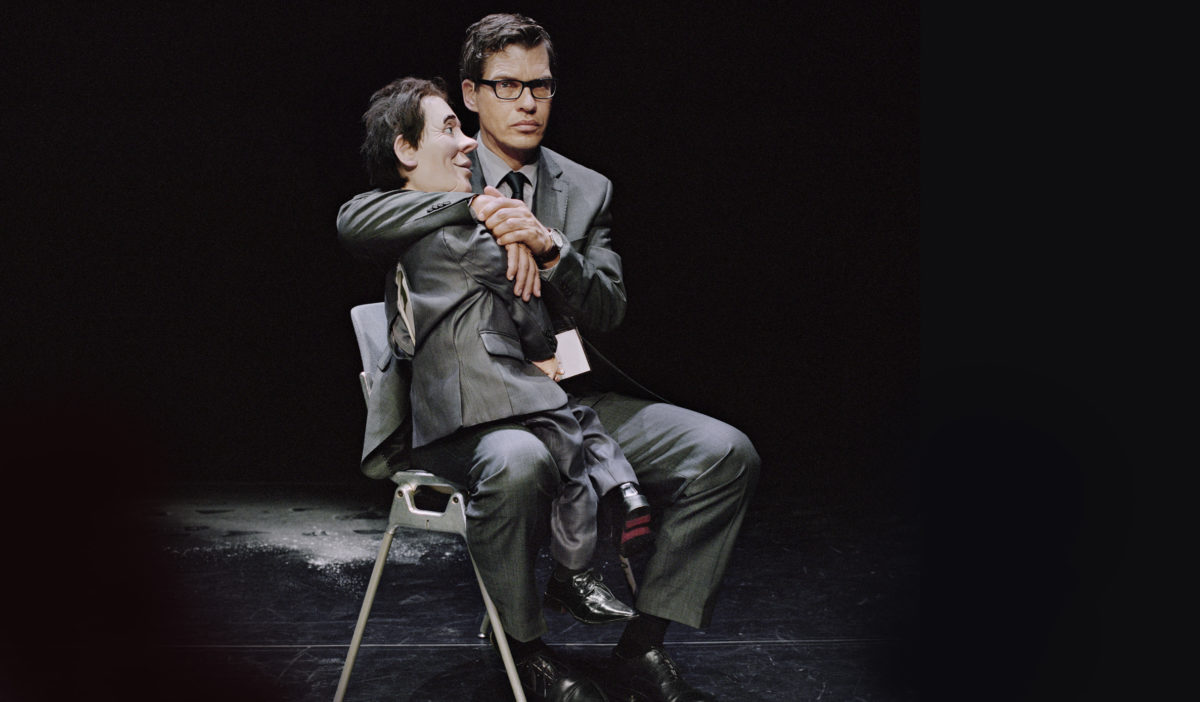
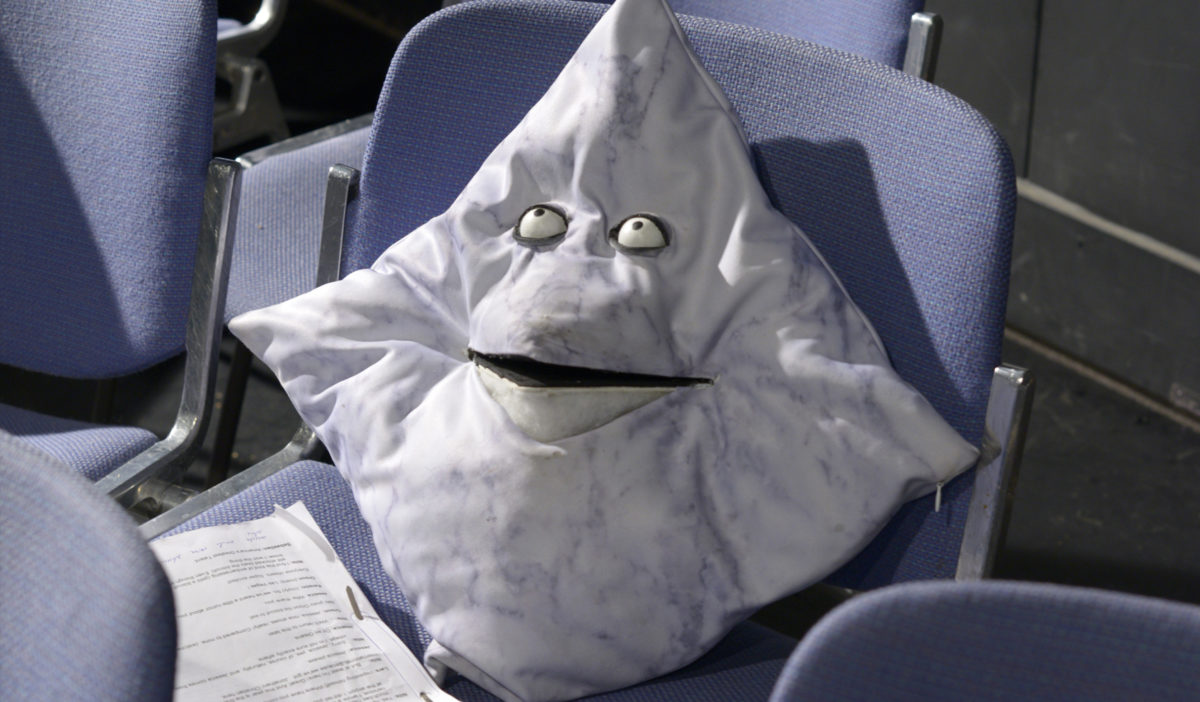
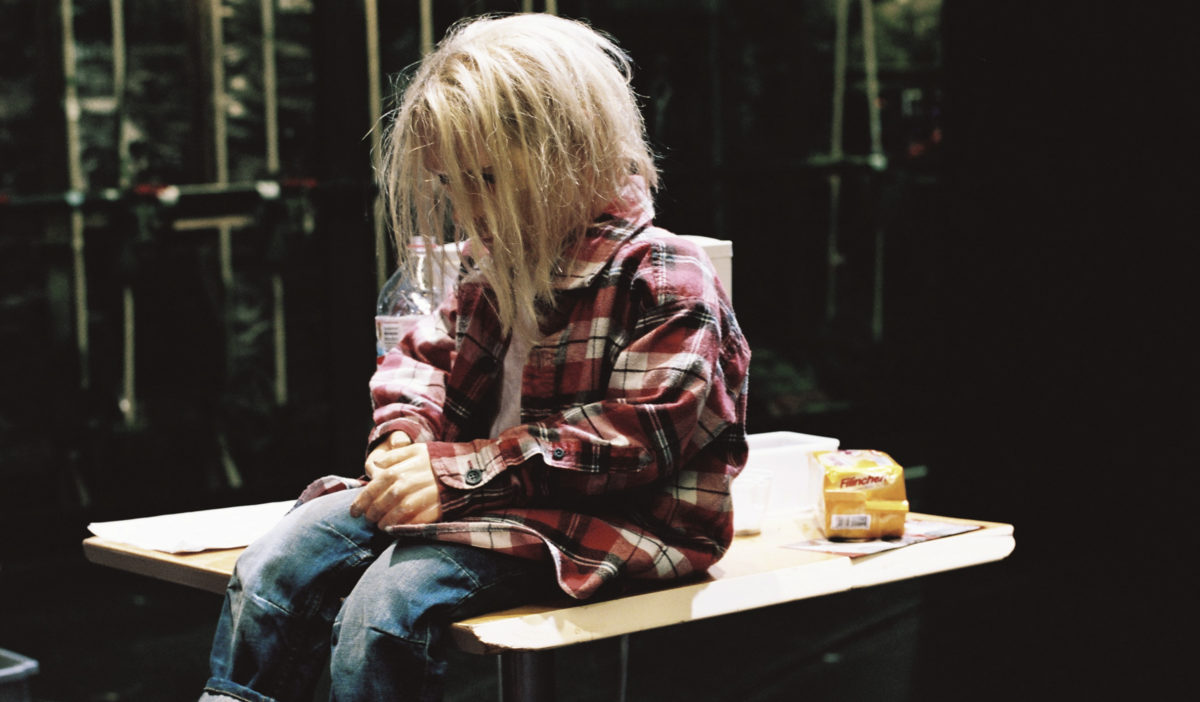
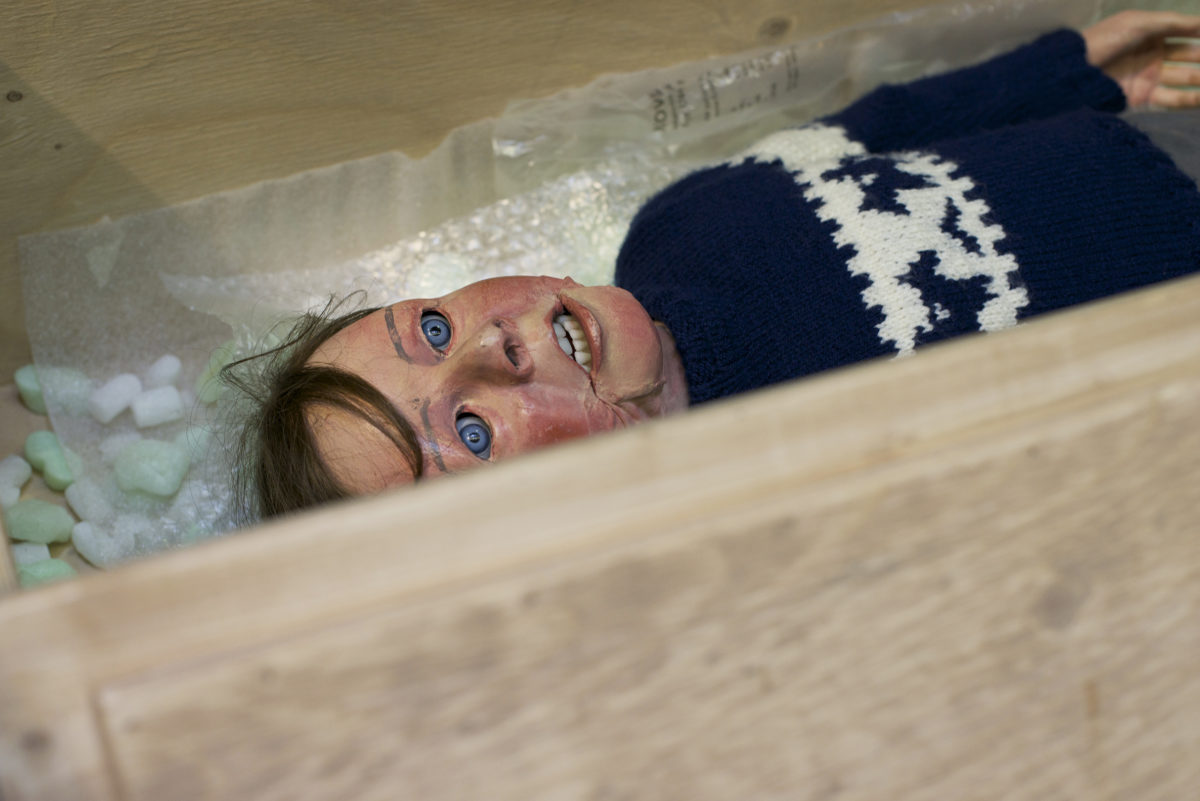
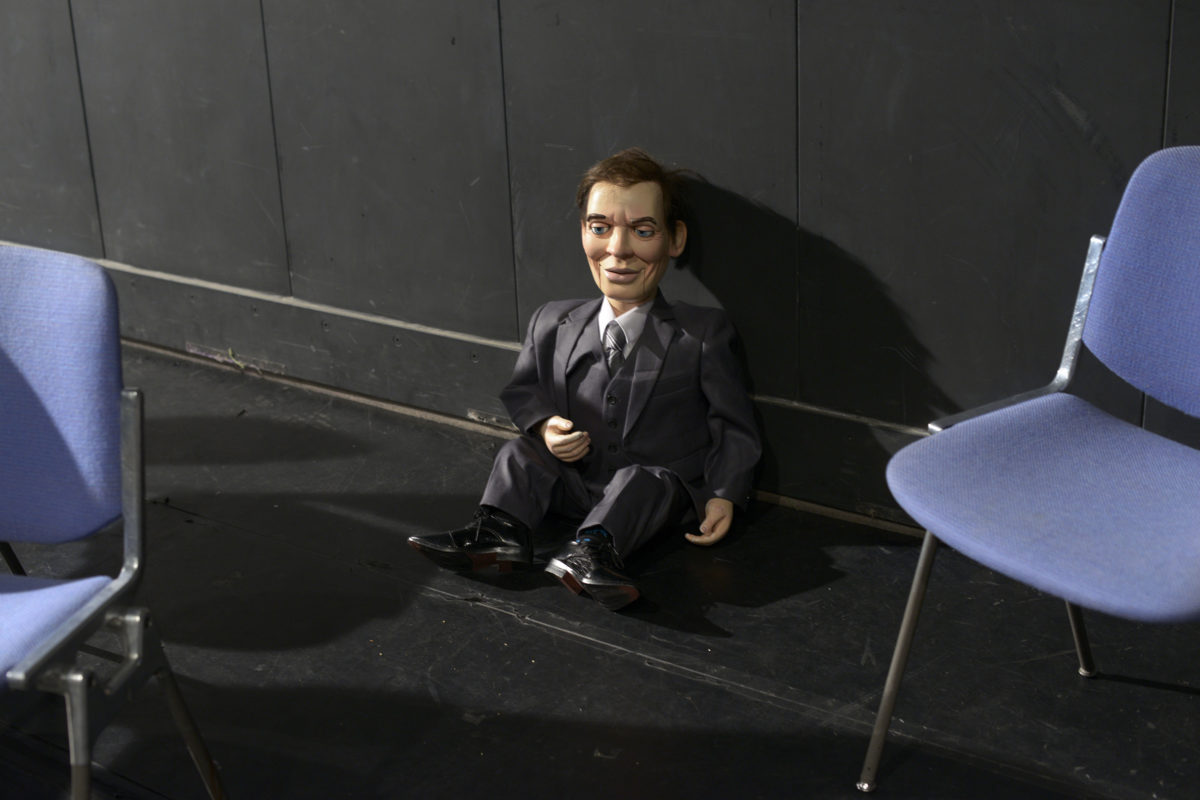
The Ventriloquists Convention
Cast
Conception & direction Gisèle Vienne
Text Dennis Cooper in collaboration with the performers
Music KTL (Stephen O’Malley & Peter Rehberg)
Light Patrick Riou
Created in collaboration with and performed by Jonathan Capdevielle, Kerstin Daley-Baradel, Uta Gebert, Vincent Göhre & the puppeteers of Puppentheater Halle : Nils Dreschke, Sebastian Fortak, Lars Frank, Ines Heinrich-Frank, Katharina Kummer replaced by Katia Petrowick starting from November 2017, and for the German version Christian Sengewald
Translations Jean-René Etienne (from English to French) & Handl Klaus (from English to German)
Accessories, scenography et costums Gisèle Vienne assisted by Angela Baumgart
Stage and scenography assistant Yana Zschiedrich
Stage assistant on tour and subtitling Anne Mousselet
Puppets conception Gisèle Vienne
Puppets making Hagen Tilp
Collaboration in making the pillow puppet Uta Gebert
Make-up and whigs for Jonathan Capdevielle and Christian Sengewald Mélanie Gerbeaux
Make-up Antje Noch
Kerstin Daley-Baradel is dressed by José Enrique Oña Selfa
Ventriloquy workshop I Marcus Geuss
Ventriloquy workshop II Michel Déjeneffe
Technical direction Puppentheater Halle Daniel Schreiner
Stage manager Puppentheater Halle Henryk Drewniok
Sound engineers Mattef Kuhlmey & Robert Nacken
Light manager Arnaud Lavisse
Project manager Puppentheater Halle Katja Podzimski
Production & booking DACM Alma Office Anne-Lise Gobin, Alix Sarrade & Pauline Civard
Administration DACM Etienne Hunsinger
Acknowledgments to Laure Fernandez, Carena Schlewitt, Stefan Kaegi, Vent Haven Museum & Vent Haven Convention, Francesca Spinazzi, Zachary Farley, Jean-Paul Vienne & Dorothéa Vienne-Pollak
Partners
Executive producers Puppentheater Halle & DACM
Coproducers Nanterre-Amandiers CDN // Festival d’Automne à Paris // Les Spectacles Vivants – Centre Pompidou // CDN Orléans/Loiret/Centre // TJP CDN d’Alsace-Strasbourg // Maillon, Théâtre de Strasbourg – Scène européenne // Internationales Sommerfestival Kampnagel, Hamburg // Le Parvis Scène nationale de Tarbes-Pyrénées // La Bâtie – Festival de Genève // Kaserne Basel // Theater Freiburg // Bonlieu Scène nationale Annecy dans le cadre du projet DIPTIC soutenu par le programme de coopération territoriale européenne INTERREG V-A France-Suisse 2014-2020 // humain Trop humain Montpellier // Fidena Festival, Bochum
With the support of Kulturstiftung des Bundes // Pro Halle e.V. // Saalesparkasse // Fachausshuss Tanz und Theater Basel Stadt-Basel Landschaft // Institut Français dans le cadre de “Théâtre export” // Bureau du théâtre et de la danse – Institut Français d’Allemagne & de l’association Beaumarchais-SACD Paris dans le cadre du programme d’aide à la production // Services culturels de l’Ambassade de France à New-York
Presentation
Each year, the state of Kentucky hosts the biggest global convention of ventriloquists in the world. The Convention takes place next to the Vent Haven Museum, a venue dedicated to the art of ventriloquism which is also a cemetery of sorts: this is where puppets who no longer perform on stage – often after the death of their owner – come to be kept and exhibited. The Convention is an opportunity for ventriloquists from all over the United States, and the rest of the world, to meet, network, make friends, and build professional relationships. Ventriloquists from very different social and professional backgrounds come here to find like-minded peers and share a common passion that is seen as unusual and sometimes downright odd by others.
Research for The Ventriloquists Convention has led us to look at ventriloquists-cum-puppeteers, focusing on real-life material primarily related to the Kentucky event, as well as fictional sources. The play specifically deals with the reasons why ventriloquists do what they do, what originally led them to take up ventriloquism, the way their work is viewed by others, as well as issues related to their gender and/or identity, and many other aspects of these curious characters.
This research also allowed us to examine the puppeteer and/or ventriloquist figure in a more generic way, as it is most commonly viewed in our psyche, and its various fictional representations, including those in films and literature. We looked at the recurrent characteristics of a character who is often seen as suspicious, strange, or even disturbing.
The Ventriloquists Convention is a highly realistic fictional work, an imagined reconstruction of the real-life, Kentucky-based annual event. Nine puppeteers-cum-ventriloquists will perform a play based on the various phases of the Convention, and take a look at the various challenges, both private and professional, facing them in their work and in the performance of their act. In a venue where multiple chairs, intended to welcome the convention’s delegates, are arranged in a simple fashion, spectators share the same perspective as ventriloquists, and feel like they are themselves part of the convention’s delegates.
The play, at first, may appear relatively simple; but it builds up as would a score, based on the manifold voices of characters whose psychological complexity is slowly revealed by their multi-layered dialogues.
Conversations between characters slowly grow from multiple voices: the voice of the ventriloquist him/herself – whether in character or not –, the voice of the puppet, and the more unusual ventriloquist “third voice” as we like to call it, devoid of any physical medium to actually carry that voice, which makes it seem disembodied. Every voice, whether natural or artificial, is unique, and easily distinguishable from other voices by its tone and by the “body” it is related to. If it is easy to accept the dramatic convention by which several characters may exist under the guise of a single physical person – the ventriloquist -, these voices subtly but firmly highlight and reveal the different facets of the ventriloquist’s personality.
Dialogues then develop based on these multiple voices, while we remain aware of this schizophrenic dichotomy. Given the context, it seems realistic and natural that the puppets should speak to each other and address their own or other ventriloquists, that the “third voice” emanating from the ventriloquist but without physical medium is aimed at ventriloquists or puppets, and that all these voices from different sources converse among themselves.
The dialogue’s various layers – i.e., what is said, what is thought, what comes from our unconscious – are therefore expressed aloud and in turns by the ventriloquist, his puppet or the third voice. Yet still, in the context of a ventriloquists’ meeting, expressing out loud all of the language’s layers that make up these conversations seems entirely natural despite what it may reveal about the characters, their privacy, and their relationships with others.
In a play where the performance is based on these various layers of dialogue, with their unspoken subtext, being uttered aloud, we can suddenly see both the madness and the normality of these conversations and the shift from seemingly uncomplicated relations to a real psychological maze.
Dennis Cooper wrote a particularly complex and distinctive dialogue for this unique play that encompasses a minimum of 27 voices performed by nine different puppeteers-cum-ventriloquists.
This performance is a continuation of our work on the multifaceted relationship between the body and the voice, through various embodiments and disembodiments of voices that allow us to examine our multi-layered psyche, as well as the importance of the chosen words within these multiple layers from a collective and individual point of view.
History
-
18, 19, 20, 21 October 2018
-
12, 13 October 2018
-
12 May 2018
-
19 November 2017
-
03 June 2017TREFF Festival, Tallinn (IE) performed in English, surtitled in Estonian
-
24 May 2017
-
11, 12 May 2017
-
06, 07 May 2017
-
26 April 2017
-
08, 09, 10 March 2017
-
01, 02 February 2017
-
22 October 2016
-
10 October 2016
-
30, 31 May 2016
-
01, 02, 03 April 2016Les Subsistances, Lyon (FR)
-
16, 17, 18, 19, 21, 22, 23, 24 March 2016TJP CDN d'Alsace-Strasbourg (FR) avec le Maillon, Théâtre de Strasbourg - Scène européenne Performed in English, surtitled in French & German
-
23, 24, 25, 26 February 2016CDN Orléans/Loiret/Centre (FR)
-
09, 10 February 2016Bonlieu Scène nationale Annecy (FR)
-
04, 05, 06 February 2016Kaserne Basel (CH)
-
29, 30 January 2016
-
26 January 2016
-
24 January 2016
-
13, 14 January 2016
-
10, 11, 12 December 2015
-
01, 02, 03, 04 December 2015
-
27, 28, 29 November 2015
-
12, 13, 14 November 2015
-
07, 08, 09, 10, 11 October 2015
-
01 October 2015
-
30 September 2015
-
19, 20 September 2015
-
03, 04 September 2015
-
21, 22, 23 August 2015
-
14, 15, 16 August 2015
